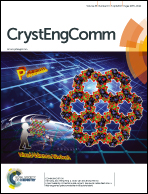Compartmental ligand approach for constructing 3d–4f heterometallic [CuII5LnIII2] clusters: synthesis and magnetostructural properties†
Abstract
The employment of a reduced Schiff-base ligand, 1,3-bis(3-methoxy-salicylamino)-2-propanol (H3L), with the assistance of acetate anions led to the isolation of eight heptanuclear heterometallic complexes containing [Cu5Ln2] cores. Single-crystal X-ray diffraction analyses have been performed for all the complexes and show that they all have dicationic [Cu5Ln2] cores with two nitrate or hexafluorophosphate anions to compensate the charge. The dicationic parts in 1–8 display centrosymmetric hexagonal-like arrangements in which one CuII ion sits on the inversion centre with six peripheral metal ions (two LnIII and four CuII) around it. The magnetic susceptibilities of all the complexes have been studied by dc magnetic measurements. The temperature dependent magnetic susceptibility data for the CuII–GdIII complex have been processed using PHI software. The results reveal that the magnetic exchange interactions between CuII and CuII ions are antiferromagnetic while those between CuII and GdIII ions are ferromagnetic. The magnetostructural correlations reveal that the bridging angles of Cu–O–Cu and Cu–O–Gd greatly influence the magnetic coupling of CuII–CuII and CuII–GdIII, respectively. Further, ac susceptibility studies have been carried out for DyIII and TbIII complexes and HoIII derivatives. The complexes CuII–HoIII and CuII–TbIII show slow magnetization relaxation behaviour of an SMM.
![Graphical abstract: Compartmental ligand approach for constructing 3d–4f heterometallic [CuII5LnIII2] clusters: synthesis and magnetostructural properties](/en/Image/Get?imageInfo.ImageType=GA&imageInfo.ImageIdentifier.ManuscriptID=C6CE02519F&imageInfo.ImageIdentifier.Year=2017)


 Please wait while we load your content...
Please wait while we load your content...